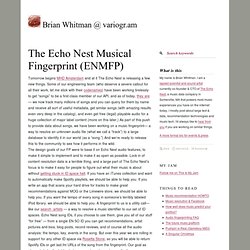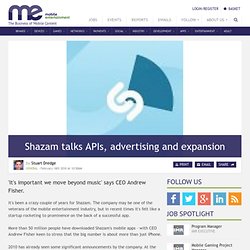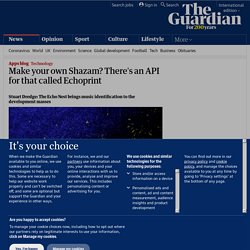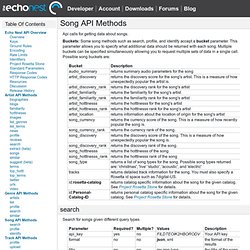

The Intelligent Music Application Platform. Notes.variogr.am - The Echo Nest Musical Fingerprint (ENMFP) Tomorrow begins MHD Amsterdam and at it The Echo Nest is releasing a few new things.

Some of our engineering team (who deserve a severe callout for all their work, let me stick with their codenames) have been working tirelessly to get “songs” to be a first-class member of our API, and as of today, they are — we now track many millions of songs and you can query for them by name and receive all sort of useful metadata, get similar songs (with amazing results even very deep in the catalog), and even get free (legal) playable audio for a huge collection of major label content (more on this later.)
As part of this push to provide data about songs, we have been working on a music fingerprint— a way to resolve an unknown audio file (what we call a “track”) to a large database to identify it in our world (as a “song.”) And we’re ready to release this to the community to see how it performs in the wild. How it works Use and open nature Almost all of this implementation is open. Features How to use. Shazam talks APIs, advertising and expansion. 'It's important we move beyond music' says CEO Andrew Fisher.

It's been a crazy couple of years for Shazam. The company may be one of the veterans of the mobile entertainment industry, but in recent times it's felt like a startup rocketing to prominence on the back of a successful app. More than 50 million people have downloaded Shazam's mobile apps – with CEO Andrew Fisher keen to stress that the big number is about more than just iPhone. 2010 has already seen some significant announcements by the company.
At the recent Midem music industry show, Shazam revealed that more than 260,000 digital music tracks are bought every day via its apps – a big deal for an industry desperate for digital growth to combat the decline in CD sales. In recent weeks, too, Shazam signed a deal with Dockers to be used in the clothing brand's Superbowl ad campaign, linked its mobile app to Pandora and Last.fm, and then this week unveiled its Shazam Audio Recognition Advertising (SARA) program. Recognition Services. Search for Music Using Your Voice by Singing or Humming, View Music Videos, Join Fan Clubs, Share with Friends, Be Discovered and Much More For Free! - midomi.com. MusicID. Echoprint - Open source music identification. Acoustic fingerprint. An acoustic fingerprint is a condensed digital summary, deterministically generated from an audio signal, that can be used to identify an audio sample or quickly locate similar items in an audio database.[1] Attributes[edit] Most audio compression techniques (AAC, MP3, WMA, Vorbis) will make radical changes to the binary encoding of an audio file, without radically affecting the way it is perceived by the human ear.

A robust acoustic fingerprint will allow a recording to be identified after it has gone through such compression, even if the audio quality has been reduced significantly. For use in radio broadcast monitoring, acoustic fingerprints should also be insensitive to analog transmission artifacts. On the other hand, a good acoustic fingerprint algorithm must be able to identify a particular master recording among all the productions of an artist or group.
Implementations[edit] This is a list of notable acoustic fingerprinting products. Proprietary Open source See also[edit] Web-API for shazam or a similar service. Echonest/echoprint-ios-sample. Make your own Shazam? There's an API for that. Yesterday, mobile discovery firm Shazam raised $32 million and talked about its ongoing move beyond basic music identification.

A good thing, too, for today US company The Echo Nest is launching a platform that lets any developer create their own baby Shazam for a fraction of the cost. It's called Echoprint, and is being touted as the world's "first fully open-source music fingerprint service", drawing on UK firm 7digital's catalogue of 13 million songs, and with plans to expand its database over time as more apps are launched using it. "Music fingerprinting should belong to the Internet," says Echo Nest co-founder and chief technology officer Brian Whitman, in a statement. Picard. Song API Methods — The Echo Nest 4.2 documentation. You can call song/identify with GET or POST.

Identifying songs with POST Posting tracks with /song/identify can be done in two manners An HTTP POST request with Content-Type "multipart/form-data" where all parameters are in the post body and the query is in the "query" parameter of the post "files"An HTTP POST request with Content-Type "application/octet-stream", with the local query file as the body of the request, and the parameters in the URL Example POSTs: Identifying songs with GET If you call song/identify with GET, you give the code parameter directly along with any metadata fields: Here is a sample query: The query parameter needs to be a JSON dictionary and can accept the following fields: metadata: a JSON dictionary containing 0 or more of the following: artist, release, title, genre, seconds, filename, version.
Code: required. Echonest (The Echo Nest)